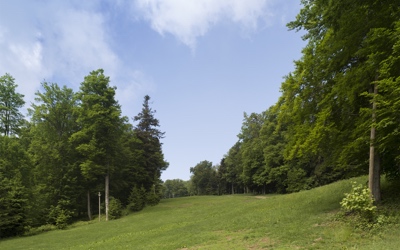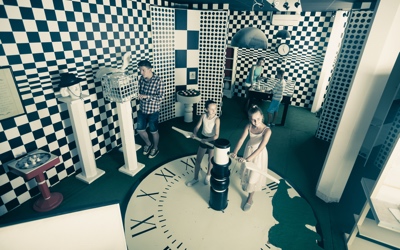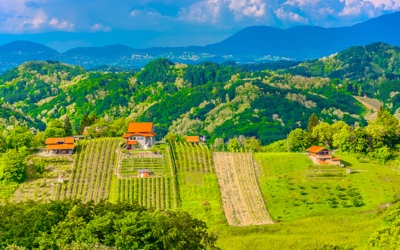
Zagreb - Rijeka - Opatija
1 day
About this activity
Itinerary
This is a typical itinerary for this product
Stop At: Kredenca Opatija, Marshala Tita 146, Opatija 51410 Croatia
Located at the foot of Ucka Mountain and Nature Park, Opatija provides a great choice for summer and winter vacations. Beautiful nature, parks, old Austro-Hungarian villas, promenades and beaches have been attracting tourists from Europe and the world for 160 years. Opatija is the leading tourist resort in the Republic of Croatia for the organization of congresses, seminars and consultations. Festivals, concerts, exhibitions and other cultural and sporting events Opatija offers culturally entertaining events throughout the year. [1]
The abbey is located on the eastern coast of the Istrian peninsula, and lies at the foot of Učka Mountain. It is the largest city and center of the Liburnian area, which extends from Plomin, along the coast and through the mountain range of Učka and Ćićarija to Rupa and Kastav.
Opatija is a tourist town, picturesque in appearance. With its tradition and appearance it stands out from other tourist cities because its, although short-lived history is very colorful.
Opatija's climate is sub-Mediterranean, which means that it is not like in Dalmatia, but the temperatures are slightly lower, and there are more rainfall and cloudy days in the year than in the southern Adriatic.
Duration: 3 hours
Stop At: Rijeka Central Market, Rijeka Croatia
Historically, Rijeka was also called Tharsatica, Vitopolis (lit. City of [Saint] Vito), or Flumen (lit. River) in Latin. The city is called Rijeka in Croatian, Reka in Slovene, and Reka or Rika in the local dialects of the Chakavian language. It is called Fiume ([ˈfjuːme]) in Italian. All these names mean "river" in their respective languages.[6][7] Meanwhile, Hungarian has adopted the Italian name while in German the city has been called Sankt Veit am Flaum—St Vito on the river Flaum—or Pflaum ([pflaʊm]).Though traces of Neolithic settlements can be found in the region, the earliest modern settlements on the site were Celtic Tharsatica (modern Trsat, now part of Rijeka) on the hill, and the tribe of mariners, the Liburni, in the natural harbour below. The city long retained its dual character. Rijeka was first mentioned in the 1st century AD by Pliny the Elder as Tarsatica in his Natural History (iii.140).[8]
In the time of Augustus, the Romans rebuilt Tharsatica as a municipium Flumen (MacMullen 2000), situated on the right bank of small river Rječina (whose name means "the big river"). It became a city within the Roman Province of Dalmatia until the 6th century.After the 4th century Rijeka was rededicated to St. Vitus, the city's patron saint, as Terra Fluminis sancti Sancti Viti or in German Sankt Veit am Pflaum. From the 5th century onwards, the town was ruled successively by the Ostrogoths, the Byzantines, the Lombards, and the Avars. Croats settled the city starting in the 7th century giving it the Croatian name, Rika svetoga Vida ("the river of St. Vitus"). At the time, Rijeka was a feudal stronghold surrounded by a wall. At the center of the city, its highest point, was a fortress.
In 799 Rijeka was attacked by the Frankish troops of Charlemagne. Their Siege of Trsat was at first repulsed, during which the Frankish commander Duke Eric of Friuli was killed. However, the Frankish forces finally occupied and devastated the castle, while the Duchy of Croatia passed under the overlordship of the Carolingian Empire. From about 925, the town was part of the Kingdom of Croatia, from 1102 in personal union with Hungary. Trsat Castle and the town was rebuilt under the rule of the House of Frankopan. In 1288 the Rijeka citizens signed the Law codex of Vinodol, one of the oldest codes of law in Europe.
Rijeka even rivalled with Venice when it was purchased by the Habsburg emperor Frederick III, Archduke of Austria in 1466. It would remain under Habsburg overlordship for over 450 years, except for French rule between 1805 and 1813, until its occupation by Croatian and subsequently Italian irregulars at the end of World War I
Duration: 3 hours
Read more
Show less
This is a typical itinerary for this product
Stop At: Kredenca Opatija, Marshala Tita 146, Opatija 51410 Croatia
Located at the foot of Ucka Mountain and Nature Park, Opatija provides a great choice for summer and winter vacations. Beautiful nature, parks, old Austro-Hungarian villas, promenades and beaches have been attracting tourists from Europe and the world for 160 years. Opatija is the leading tourist resort in the Republic of Croatia for the organization of congresses, seminars and consultations. Festivals, concerts, exhibitions and other cultural and sporting events Opatija offers culturally entertaining events throughout the year. [1]
The abbey is located on the eastern coast of the Istrian peninsula, and lies at the foot of Učka Mountain. It is the largest city and center of the Liburnian area, which extends from Plomin, along the coast and through the mountain range of Učka and Ćićarija to Rupa and Kastav.
Opatija is a tourist town, picturesque in appearance. With its tradition and appearance it stands out from other tourist cities because its, although short-lived history is very colorful.
Opatija's climate is sub-Mediterranean, which means that it is not like in Dalmatia, but the temperatures are slightly lower, and there are more rainfall and cloudy days in the year than in the southern Adriatic.
Duration: 3 hours
Stop At: Rijeka Central Market, Rijeka Croatia
Historically, Rijeka was also called Tharsatica, Vitopolis (lit. City of [Saint] Vito), or Flumen (lit. River) in Latin. The city is called Rijeka in Croatian, Reka in Slovene, and Reka or Rika in the local dialects of the Chakavian language. It is called Fiume ([ˈfjuːme]) in Italian. All these names mean "river" in their respective languages.[6][7] Meanwhile, Hungarian has adopted the Italian name while in German the city has been called Sankt Veit am Flaum—St Vito on the river Flaum—or Pflaum ([pflaʊm]).Though traces of Neolithic settlements can be found in the region, the earliest modern settlements on the site were Celtic Tharsatica (modern Trsat, now part of Rijeka) on the hill, and the tribe of mariners, the Liburni, in the natural harbour below. The city long retained its dual character. Rijeka was first mentioned in the 1st century AD by Pliny the Elder as Tarsatica in his Natural History (iii.140).[8]
In the time of Augustus, the Romans rebuilt Tharsatica as a municipium Flumen (MacMullen 2000), situated on the right bank of small river Rječina (whose name means "the big river"). It became a city within the Roman Province of Dalmatia until the 6th century.After the 4th century Rijeka was rededicated to St. Vitus, the city's patron saint, as Terra Fluminis sancti Sancti Viti or in German Sankt Veit am Pflaum. From the 5th century onwards, the town was ruled successively by the Ostrogoths, the Byzantines, the Lombards, and the Avars. Croats settled the city starting in the 7th century giving it the Croatian name, Rika svetoga Vida ("the river of St. Vitus"). At the time, Rijeka was a feudal stronghold surrounded by a wall. At the center of the city, its highest point, was a fortress.
In 799 Rijeka was attacked by the Frankish troops of Charlemagne. Their Siege of Trsat was at first repulsed, during which the Frankish commander Duke Eric of Friuli was killed. However, the Frankish forces finally occupied and devastated the castle, while the Duchy of Croatia passed under the overlordship of the Carolingian Empire. From about 925, the town was part of the Kingdom of Croatia, from 1102 in personal union with Hungary. Trsat Castle and the town was rebuilt under the rule of the House of Frankopan. In 1288 the Rijeka citizens signed the Law codex of Vinodol, one of the oldest codes of law in Europe.
Rijeka even rivalled with Venice when it was purchased by the Habsburg emperor Frederick III, Archduke of Austria in 1466. It would remain under Habsburg overlordship for over 450 years, except for French rule between 1805 and 1813, until its occupation by Croatian and subsequently Italian irregulars at the end of World War I
Duration: 3 hours
Included
- Dress code is smart casual
- Stroller accessible
- Local licensed guide for Diocletian Palace and Split downtown
- Infant seats available
- Air-conditioned vehicle
- All Fees and Taxes
- Bottled water
- Private transportation
- WiFi on board
Not included
- Entry/Admission - Kredenca Opatija
- Entry/Admission - Rijeka Central Market
Additional
- Confirmation will be received at time of booking
- Infant seats available
- Near public transportation
- Stroller accessible
- Not wheelchair accessible
- Travelers should have a moderate physical fitness level
- This experience requires a minimum number of travelers. If it’s canceled because the minimum isn’t met, you’ll be offered a different date/experience or a full refund
- This is a private tour/activity. Only your group will participate
Features
Original
55%
Sport
55%
Cultural
35%
Tourism
35%
You may also like









 See all 26 Collections
See all 26 Collections
Click to discover other experiences
See all

Collections
Medvednica Nature Park
8 Activities

Collections
Balkan Discoveries
64 Activities

Collections
Castles
38 Activities

Collections
Original
38 Activities

Collections
E-scooting
6 Activities

Collections
Truffle Hunting
4 Activities

Collections
National Parks
22 Activities

Collections
Kumrovec
6 Activities

Collections
Trakoscan
21 Activities

Collections
Varazdin & Zagorje
25 Activities

